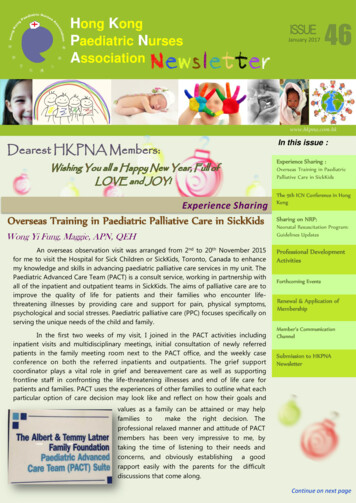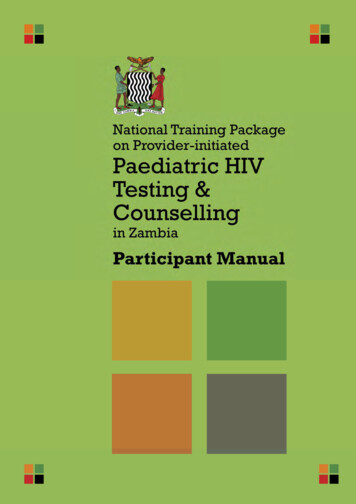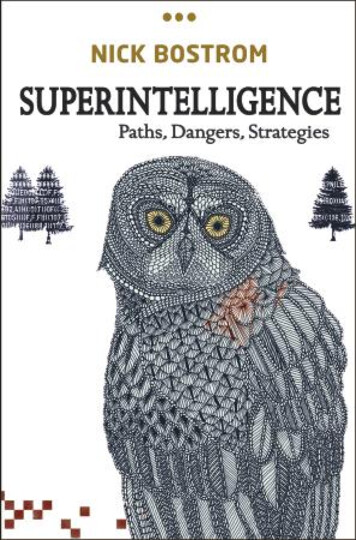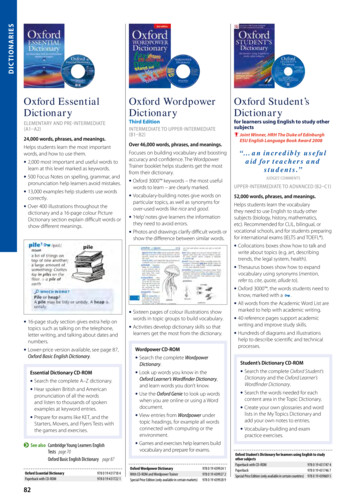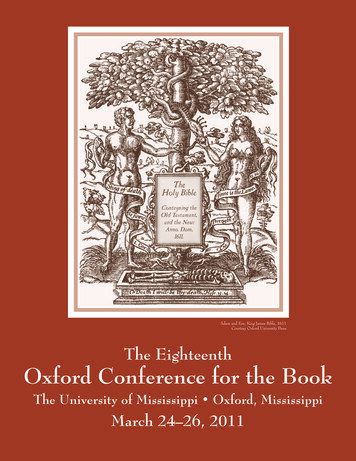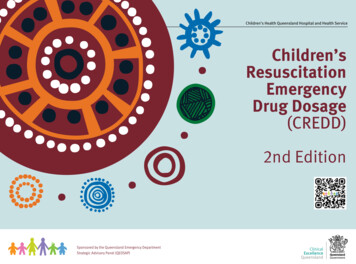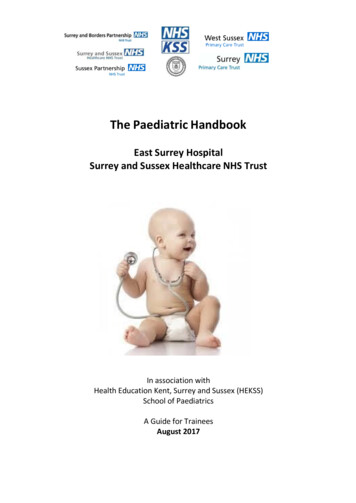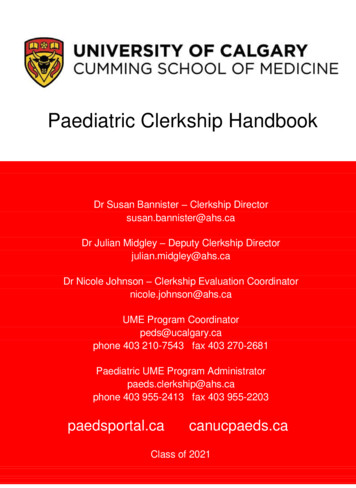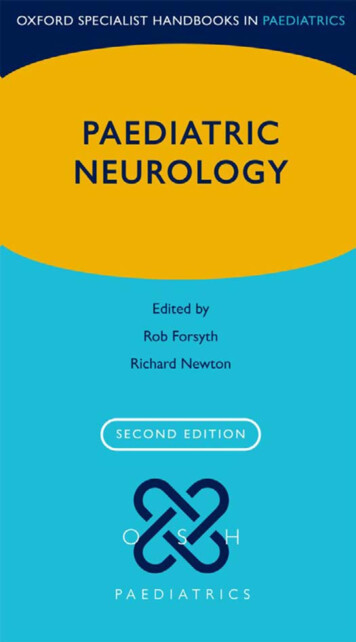
Transcription
OXFORD MEDICAL PUBLICATIONSPaediatricNeurology
Oxford Specialist HandbooksGeneral Oxford SpecialistHandbooksA Resuscitation Room GuideAddiction MedicineDay Case SurgeryPerioperative Medicine, 2ePostoperative Complications, 2eRenal TransplantationOxford Specialist Handbooksin AnaesthesiaAnaesthesia for Medical and SurgicalEmergenciesCardiac AnaesthesiaNeuroanaethesiaObstetric AnaesthesiaOphthalmic AnaesthesiaPaediatric AnaesthesiaRegional Anaesthesia, Stimulation andUltrasound TechniquesThoracic AnaesthesiaOxford Specialist Handbooksin CardiologyAdult Congenital Heart DiseaseCardiac Catheterization andCoronary InterventionCardiac Electrophysiology andCatheter AblationCardiovascular ComputedTomographyCardiovascular Magnetic ResonanceEchocardiography, 2eFetal CardiologyHeart FailureHypertensionInherited Cardiac DiseaseNuclear CardiologyPacemakers and ICDsPulmonary HypertensionValvular Heart DiseaseOxford Specialist Handbooksin Critical CareAdvanced Respiratory Critical CareOxford Specialist Handbooksin End of Life CareEnd of Life Care in CardiologyEnd of Life Care in DementiaEnd of Life Care in NephrologyEnd of Life Care in RespiratoryDiseaseEnd of Life in the Intensive Care UnitOxford Specialist Handbooksin NeurologyEpilepsyParkinson’s Disease and OtherMovement DisordersStroke MedicineOxford Specialist Handbooksin PaediatricsPaediatric DermatologyPaediatric Endocrinology and DiabetesPaediatric Gastroenterology,Hepatology, and NutritionPaediatric Haematology and OncologyPaediatric Intensive CarePaediatric Nephrology, 2ePaediatric Neurology, 2ePaediatric RadiologyPaediatric Respiratory MedicinePaediatric RheumatologyOxford Specialist Handbooksin Pain MedicineSpinal Interventions in PainManagementOxford Specialist Handbooksin PsychiatryChild and Adolescent PsychiatryForensic PsychiatryOld Age PsychiatryOxford Specialist Handbooksin RadiologyInterventional RadiologyMusculoskeletal ImagingPulmonary ImagingThoracic ImagingOxford Specialist Handbooksin SurgeryCardiothoracic SurgeryColorectal SurgeryHand SurgeryHepatopancreatobiliary SurgeryNeurosurgeryOperative Surgery, 2eOral Maxillofacial SurgeryOtolaryngology and Head and NeckSurgeryPaediatric SurgeryPlastic and Reconstructive SurgerySurgical OncologyUrological SurgeryVascular Surgery
Oxford SpecialistHandbooks inPaediatricsPaediatricNeurologySecond editionEdited byRob ForsythConsultant and Senior Lecturer in Child NeurologyGreat North Children’s Hospital, Newcastle, UKRichard NewtonConsultant Paediatric NeurologistRoyal Manchester Children’s Hospital, UK1
1Great Clarendon Street, Oxford, OX2 6DP,United KingdomOxford University Press is a department of the University of Oxford.It furthers the University’s objective of excellence in research, scholarship,and education by publishing worldwide. Oxford is a registered trade mark ofOxford University Press in the UK and in certain other countries Oxford University Press 2012The moral rights of the authors have been assertedFirst Edition published 2007Second Edition published 2012Impression: 1All rights reserved. No part of this publication may be reproduced, stored ina retrieval system, or transmitted, in any form or by any means, without theprior permission in writing of Oxford University Press, or as expressly permittedby law, by licence or under terms agreed with the appropriate reprographicsrights organization. Enquiries concerning reproduction outside the scope of theabove should be sent to the Rights Department, Oxford University Press, at theaddress aboveYou must not circulate this work in any other formand you must impose this same condition on any acquirerBritish Library Cataloguing in Publication DataData availableLibrary of Congress Cataloging in Publication DataData availableISBN 978–0–19–960363–3Printed in Great Britainon acid-free paper byAshford Colour Press Ltd, Gosport, HampshireOxford University Press makes no representation, express or implied, that thedrug dosages in this book are correct. Readers must therefore always checkthe product information and clinical procedures with the most up-to-datepublished product information and data sheets provided by the manufacturersand the most recent codes of conduct and safety regulations. The authors andthe publishers do not accept responsibility or legal liability for any errors in thetext or for the misuse or misapplication of material in this work. Except whereotherwise stated, drug dosages and recommendations are for the non-pregnantadult who is not breast feeding.Links to third party websites are provided by Oxford in good faith andfor information only. Oxford disclaims any responsibility for the materialscontained in any third party website referenced in this work.
DedicationFor our families:Pip, Beth, and Ellen; Judith, Sarah, Michael, and JenniferAnd from all the contributors:Thanks to our own families, and those we meet through our work,who support us and teach us so much.
viPreface to thesecond editionThe very gratifying response to the first edition of this book has justifiedour belief in the value of a team approach: contributors with their fingerson the pulse of advances in our field, steadied at the helm by two editorswith experience and perspective. It has, again, been a great privilege: neverhas Lord Acton’s advice to ‘learn as much from writing books as fromreading them’ been better heeded!We have appreciated the very constructive suggestions for improvementof the first edition and followed them where we can. We have addedrespiratory consults to Chapter 5, and included more neuroradiology,diagrams, and images in situations where they offer clarity. A section onlate-onset metabolic disease is added with an emphasis on how this groupof disorders might catch us out.With an ever-increasing list of genes and autoantibodies to think aboutit is important to remember those everyday skills we carry, honed asjuniors in our specialty: listening to what is truly being said, careful clinicalexamination, focused investigation, and above all the communication ofunderstanding, reassurance, and hope to families and young people facingchallenges they never dreamed existed. You will find due emphasis on thisin the text.We trust this book will become a trusted companion. Please continueto tell us how it can be improved!RFRN2012
viiPreface to thefirst editionMedicine is a communal discipline, and this book has benefited greatlyfrom being written in community by trainees (who remember the recentstruggle to grasp a complex area) and older colleagues who can add particular emphases and perspective. We have striven to provide a combination of practical advice on clinical approach, and ‘at a glance’ oversightsand aides-memoire to topic areas. We also wanted to address a numberof practical issues that occupy a lot of time in practice, but that are rarelyaddressed in more conventional textbooks.RFRN2007
viiiAcknowledgementsWe are grateful to colleagues Hilary Cass and Chris O’Brien for their contributions to the sections on b p. 114 and b p. 254, respectively. RobertMacFarland reviewed the section on mitochondrial disease and SimonBailey commented on the CNS tumour section. We thank Susan Kafka,Clinical Pharmacist at Royal Manchester Children’s Hospital for her expertreview of the pharmacopoeia. Stavros Stivaros, also of Royal ManchesterChildren’s Hospital provided some MR images. Hilary Reidpath, SeniorTechnician in the Neurophysiology Department at the Royal Hospital forSick Children Glasgow and Dr Ming Lai, Consultant Neurophysiologist atthe Royal Victoria Infirmary, Newcastle kindly supplied EEG illustrations.We are very grateful to Nuno Cordeiro, Christian de Goede, andOmar Kwaja who contributed so generously to the first edition. We areparticularly grateful to Anna Basu, Ram Kumar, and Kate Riney for detailedproof-reading but any remaining errors are of course our responsibility.RFRN2012
ixContentsDetailed contents xiContributors xvSymbols and abbreviations xvi1234567Clinical approachNeurodiagnostic toolsSigns and symptomsSpecific conditionsConsultation with other servicesEmergenciesPharmacopoeiaIndex 621151103209469533573
This page intentionally left blank
xiDetailed contentsContributors xvSymbols and abbreviations xvi1 Clinical approachThe consultation 21What, where, and when 4History taking 6Examination 8Higher cognitive function 13Cranial nerves 16Peripheral nervous system 25Neonatal neurological examination 41Real world examination sequences 45Synthesis 492 Neurodiagnostic toolsPrinciples of investigation 52Principles of neuroradiology 54Neuroradiological anatomy 64Brainstem anatomy 69Principles of neurophysiology 7051Peripheral neurophysiological tests 76Neurophysiological testing of central sensory pathways 82Specialist investigations 85Practical procedures 94Neuropsychological testing 993 Signs and symptomsAgitation and confusion 104Back pain 106Behaviour disorders 107Developmental impairment 109Exercise limitation and muscle pain 117Eye movement abnormalities 119103
xiiDETAILED CONTENTSFacial movement abnormalities 126Facial sensation abnormalities 130The floppy infant 132Foot deformities 135Funny turns: episodic events 136Funny turns: likely epilepsy? 141Gait abnormalities 144Head shape abnormalities 146Head size abnormalities 148Headache 151Hearing loss 155Incontinence 157Movement abnormalities 159Magnetic resonance imaging and brain development 163Unexpected findings on magnetic resonance imaging 167White matter abnormalities on magnetic resonance imaging 170Numbness, pain, tingling, and sensory disturbance 174Peripheral weakness 176Psychomotor regression 179School failure 186Sleep disturbance 188Speech difficulties 192Swallowing and feeding problems 194Toe walking 196Unsteadiness and falls 197Visual disturbances 2004 Specific conditionsAcquired brain injury 210Acquired spinal cord injury 215Autoimmune disease of the central nervous system 218‘Autoinflammatory’ conditions 223Autoimmune encephalitides 224Cerebral palsies 227Care of the disabled child 240Feeding 248Communication 251209
DETAILED CONTENTSSpecial senses 252Respiratory disease in neurodisability 254Demyelinating disease 257Epilepsy 262Investigating epilepsy 275Am I missing an underlying cause? 280Treatment of epilepsy 286Epilepsy and daily life 298Non-epileptic paroxysmal phenomena 304Functional illness 311Headache 317Hydrocephalus 324Spina bifida and related disorders 329Idiopathic (‘benign’) intracranial hypertension 334Infection of the central nervous system 336Congenital infection 355Late-onset metabolic disease 365Mitochondrial disease 369Movement disorders 375Neuromuscular conditions: introduction 390Neuropathies 392Disorders of muscle 399Anterior horn cell disease 410Myasthenic syndromes 411Management of neuromuscular disease 416Neurocutaneous syndromes 418Neurodegenerative conditions 425Neurotransmitter disorders 435Sleep disorders 439Stroke 446Cerebral haemorrhage 452Tumours of the central venous system 454Vitamin-responsive conditions 4625 Consultation with other servicesGeneral principles 470Cardiology consultations 471469xiii
xivDETAILED CONTENTSEndocrinology consultations 474Gastroenterology consultations 476Neonatal neurology 480Neonatal encephalopathy 487Neurosurgical consultations 500Oncology consultations 502PICU consultations 507Psychiatry consultations 517Neuropsychiatric liaison work 520Renal consultations 523Respiratory consultations 526Rheumatology consultations 5316 Emergencies533Acute agitation 534Emergency management of coma 536Traumatic coma 541Status epilepticus 544Status dystonicus 551Sudden onset visual loss 558The child who suddenly stops walking 559Acute ataxia 5727 PharmacopoeiaPharmacopoeia: A–Z 574Acute sedation protocols 619Interactions of anti-epileptic drugs 619Index 621573
xvContributorsAnna BasuAndrew LuxClinical Lecturer, NewcastleUniversity and Specialist Registrar,Great North Children’s Hospital,Newcastle upon Tyne, UKConsultant Paediatric Neurologist,Bristol Royal Hospital forChildren, UKRob ForsythConsultant PaediatricNeurologist, Royal ManchesterChildren’s Hospital, UKSenior Lecturer, NewcastleUniversity and ConsultantPaediatric Neurologist, GreatNorth Children’s Hospital,Newcastle upon Tyne, UKCheryl HemingwayConsultant Paediatric Neurologist,Great Ormond Street Hospital,London, UKImelda HughesConsultant PaediatricNeurologist, Royal ManchesterChildren’s Hospital, UKRachel KneenConsultant Paediatric Neurologist,Alder Hey Children’s Hospital,Liverpool, UKRam KumarConsultant Paediatric Neurologist,Alder Hey Children’s Hospital,Liverpool, UKRichard NewtonKi PangConsultant Paediatric Neurologist,Great North Children’s Hospital,Newcastle upon Tyne, UKKate RineyConsultant PaediatricNeurologist, Mater Children’sHospital, Brisbane, AustraliaSophia VaradkarConsultant Paediatric Neurologist,Great Ormond Street Hospital,London, UKGrace VassalloConsultant PaediatricNeurologist, Royal ManchesterChildren’s Hospital, UK
xviSymbols and uorouracil5-hydroxyindoleacetic acid5-methyl terahydrofolateassistive/augmentative communicationL-alpha-aminoadipic semialdehydeairway, breathing, circulationarterial blood gasesacquired brain injuryangiotensin converting enzymeanticholinesteraseacetylcholine receptoradrenocorticotrophic hormoneautosomal dominantautosomal dominant acute necrotising encephalopathyapparent diffusion coefficient (in MRI)acute disseminated encephalomyelopathyattention deficit hyperactivity disorderadenosine diphosphateAutism Diagnostic Inventory/Observation ScheduleAccident and Emergencyanti-epileptic drugacid-fast bacillialpha-foeto proteinAicardi–Goutièrres syndromeacute inflammatory demyelinating neuropathyacquired immunodeficiency syndromeacute lymphoblastic leukaemiaalanine amino-transaminaseacute life-threatening eventsacute motor axonal neuropathyarthrogryposis multiplex congenitaladenosine e proprionicacid (receptor)acute motor and sensory axonal neuropathyantinuclear antibody
SYMBOLS AND neutrophil cytoplasmic antibodiesataxia oculomotor ataxiaanteroposteriorafferent pupillary defectautosomal recessiveanti-retroviral treatmentanti-streptolysin O titreaspartate aminotransferaseataxia telangiectasiaataxia telangiectasia mutated proteinadenosine tri-phosphatearterioventicularataxia with vitamin E deficiencyarteriovenous malformationbrainstem auditory evoked response/potentialBritish Ability Scalesblood–brain barrierbis-chloroethylnitrosourea or carmustineBacillus Calmette–Guérintwice dailybenign epilepsy with centrotemporal spikesbenign familail neonatal seziuresbilirubin-induced neurological dysfunctionbilevel positive airway pressure(inf.) glucose monitoring stripbenign myoclonic epilepsy of infancyBecker muscular dystrophybone marrow transplantBritish National Formulary for Childrenbenign neonatal syndromeblood pressurebrainstem deathchildhood ataxia with CNS hypomyelination(Vanishing White Matter disease)cerebral autosomal dominant arteriopathy withsubcortical infarcts and leukoencephalopathychildhood absence epilepsychild and adolescent mental health servicescerebral blood flowcognitive-behavioural therapycarbamazepinexvii
xviiiSYMBOLS AND VCOACHCOXCPEOCPCPPC/RCRMCCCRPCRPSCSECSFcontrolled drugcongenital disorder of glycosylation (also known ascarbohydrate deficient glycoprotein syndrome)childhood epilepsy with occipital paroxysmscerebral function analysing monitorcongenital fibrosis of extraocular muscleschronic fatigue syndrome/myalgic encephalomyelopathychronic granulomatous diseasecomparative genome hybridisationcoloboma, heart defects, (choanal) atresia,(growth)retardation, genital/urinary and ear abnormalities(syndrome)checklist for Autism in Toddlerschronic inflammatory demyelinating neuropathychronic infantile neurological cutaneous and articular(syndrome)clinically isolatated syndromeCreutzfeld-Jakob diseasecreatinine (phospho)kinasemuscle–brain isoenzyme of CKcompound muscle action potentialcongenital muscular dystrophycongenital myaesthenic syndromecerebro-retinal microangiopathy with calcification andcystsCharcot-Marie tooth Diseasecytomegaloviruscentral nervous systemcopy number variantcerebellar vermis hypo- or aplasia, oligophrenia,congenital ataxia, ocular coloboma and hepatic fibrosiscytochrome oxidasechronic progressive external ophthalmoplegiacerebral palsycerebral perfusion pressurecontrolled-releasecerebroretinal microangiopathy with calcification andcystsC-reactive proteincomplex regional pain syndromeconvulsive status epilepticuscerebrospinal fluid
SYMBOLS AND pinal irradiationcerebral salt wastingcontinuous spike-wave discharges during slow wave sleepcomputed tomographycomputed tomographic angiographycardiotocographcerebrovascular accidentcerebral (or cortical) visual impairmentcommon variable immunodeficiencycentral venous pressurecontinuous veno-venous haemofiltrationchest X-raydopaminedisorders of attention, motor processing, and perceptiondevelopmental co-ordination disorderdesmopressindual-energy X-ray absorptiometrydiabetes insipidusdiabetes insipidus, diabetes mellitus, optic atrophyand deafness.diffuse intrinsic brainstem gliomasdiabetes ketoacidosismyotonic dystrophyDuchenne muscular dystrophydistal motor latencydysembryoplastic neuroepithelial tumourL-DOPA responsive dystoniadentato-rubral-pallido-luysian atrophydigital subtraction angiographydiagnostic and statistical manual of mentaldisorders–Fourth editiondiffusion tensor imaging (MRI)deep tendon reflexdiffusion-weighted image (MRI)Epstein–Barr viruselectrocardiogramextra-corporeal membrane oxygenationextra-dural haemorrhageelectroencephalographyearly infantile epileptic encephalopahty(Ohtahara syndrome)xix
xxSYMBOLS AND MSenzyme-linked immunosorbent assayelectron microscopyepileptic absence syndromeepilepsy with myoclonic-astatic seizuresEmery–Dreyfuss muscular dystrophyearly myoclonic encephalopathyelectromyographyear, nose, and throatelectrooculogramearly onset sarcoidepilepsia partialis continuaepinephrineelectroretinogramelectrical status during slow-wave sleep (synonymouswith CSWS)erythrocyte sedimentation rateendotracheal tubeextra-ventricular drainFriedreich ataxiafatty acidfunctional endoscopic evaluation of swallowingfactitious or induced illnessfull blood countFukuyama congenital muscular dystrophyflurodeoxy-glucose positron emission tomographyfunctional independence measurefluorescent in-situ hybridisationfluid attenuated inversion recovery–MRI sequencefunctional MRIfragile X–locusfacioscapulohumeral muscular dystrophyfluorescence trepoanema antibody-absorbed syndromefailure to thriveforced vital capacitygeneral anaesthesiaguanidinoacetategamma amino-butyric acidglycosaminoglycansguanidinoacetate methyltransferaseGuillain-Barré syndromegas chromatography mass spectroscopy
SYMBOLS AND ABBREVIATIONSGCSGCTGEFS GHBGIGITGLUT1 BDICD-10ICFICPICUGlasgow coma scoregerm cell tumourgeneralized epilepsy with febrile seizures plusgamma hydroxy-butyrategastrointestinalgastrointestinal tractglucose transporter enzyme 1 deficiency syndromegangliosidegranulocyte–macrophage colony-stimulating factorgross motor function classification syndromegross motor function measuregerminal matrix haemorrhagegross motor performance measuregastro-esophageal reflux diseaseglycogen storage diseasegeneralized tonic-clonic (seizure)highly active anti-retroviral therapyhuman chorionic gonadotrophinhigh dependency unithaemolysis, elevated liver enzymes with low plateletcountHerpes hominis virushypoxic-ischaemic encephalopathyhuman immunodeficiency virushaemophagocytic lymphohistiocytosishuman leucocyte antigenhereditary motor neuropathyhereditary sensory motor neuropathyhereditary neuropathy with liability to pressure palsieshypertrophic obstructive cardiomyopathyHIV-associated progressive encephalopathyhereditary sensory and autonomic neuropathyHerpes simplex virushaemolytic uraemic syndromehomo-vanilic acidinflammatory bowel diseaseInternational Classification of Diseases v.10International classification of Functioning, Disabilityand Healthintracranial pressureintensive care unitxxi
xxiiSYMBOLS AND L-DOPALDLDHLELEVLFTLGMDLGSLHONLKSinfectious diseasesinsulin dependent diabetes mellitusiso-electric focusinginborn errors of metabolisminterferon-Aidiopathic intracranial hypertensionInternational League against Epilepsyintramuscularinfantile neuraxonal dystrophyinternuclear ophthalmoplegiainternational normalization ratiointraocular pressureintraparenchymal haemorrhageinfantile spasmsintrathecalintrauterine growth retardationintravenousisovaleric acidaemiaintraventricular hemorrhageintravenous immunoglobulinjuvenile absence epilepsyJapanese encephalitis virusjuvenile idiopathic arthritisjuvenile myoclonic epilepsyjuvenile rheumatoid arthritisKawasaki diseaseKaiser-Fleischer (ring)Kearn–Sayre syndromelymphocytic choriomeningitis virusL-3,4-dihydroxyphenylalanine (levodopa)learning difficultylactate dehydrogenaselupus erythematosus (also a particular cell seen in bloodfilm in lupus erythematosuslevetiracetamliver function testlimb girdle muscular dystrophyLennox-Gastaut syndromeLeber's hereditary optic neuropathyLandau-Kleffner syndrome
SYMBOLS AND MRMMSEMNGIEMPGRMPSMRAMRCMRIMRSMRVMSMS/MSMSUDlower motor neuronelast menstrual periodlow molecular weight heparinlumbar puncturemovement assessment battery for childrenmono-amine oxidasemean arterial pressuremiddle cerebral arterymedium chain acyl coenzyme Amicroscopy, culture, and sensitivitymedium chain triglyceridemuscular dystrophymuscle eye brain diseasemethyl-CpG-binding protein 2 gene–common Rettsyndrome genemitochondrial encephalomyopathy, lactic acidosis, andstrokelike episodesmyoclonic epilepsy and ragged-red fibremonoclonal gammopathy of unknown significancemalignant hyperthermiameta-iodobenzyl guanidine (Iodine123)metachromatic leucodystrophymedial longitudinal fasciculusmultiplex ligation-dependent probe amplificationmultiple sleep latency testmethylmalonic acidaemiamycophenylate mofetilmumps, measles and rubellamini mental state examinationmyopathy and external ophthalmoplegia;Neuropathy; Gastro-Intestinal; Encephalopathymulti-planar gradient echo sequence–on MRImucopolysaccharidosismagetic Resonance AngiographyMedical Research Councilmagnetic resonance imagingmagnetic resonance spectroscopymagnetic resonance venographymultiple sclerosistandem mass spectroscopymaple syrup urine diseasexxiii
xxivSYMBOLS AND Tmethylene tetrahydrofolatemotor unit potentialmusculo-specific kinasemaintenance of wakefulness testnicotinamide adenine dinucleotideNADH-tetrazolium reductasenon-accidental injuryneuropathy, ataxia and retinitis pigmentosaneurodegeneration with brain iron accumulationneurocysticercosisneuronal ceroidal lipofuscinosisnon-convulsive status epilepticusnerve conduction velocitynorepinephrinenecrotizing enterocolitisnon-epileptic attack disorderneurofibromatosisnasogastric tubeNational Institute of Clinical Excellenceneonatal intensive care unitNational Institutes of Healthnon-invasive positive pressure ventilationnon-ketotic hyperglycinemianeuromuscular diseaseN-methyl-D-aspartate (receptor)neuromyelitis opticanegative predictive valuenon-steroidal anti-inflammatoryneural tube defectobsessive compulsive disorderoral contraceptive pillonce dailyoccipitofrontal circumerenceoligoclonal bandsoesophago-gastro-duodenoscopyoptokinetic nystagmusopsoclonus-myoclonus syndrome (Kinsbourne)optic neuritisobstructive sleep apnoeaoccupational therapist
SYMBOLS AND mary arteritis of the CNSpaediatric autoimmune neuropsychiatric disordersassociated with streptococcal infectionpontocerebellar hypoplasiapolymerase chain reactionpulmonary capillary wedge pressurepatent ductus arteriosuspervasive developmental disorderpyridoxine-dependent epilepsypyruvate dehydrogenasephenytoin equivalentpicture exchange communication systemPaediatric Evaluation of Disability Inventorypercutaneous endoscopic Gastrostomyprogressive encephalopathy with oedema, hypsarrhythmiaand optic atrophyprogressive encephalomyelitis with rigidity and myoclonuspositron-emission tomographypatent foramen ovalephenytoinpaediatric intensive care unitpantothenate kinase-associated sociated neurodegenerationperiodic lateralized epileptiform dischargespyridoxal 5-phosphatePelizaeus–Merzbacher diseaseprogressive myoclonus epilepsyprogressive multifocal leucoencephalopathyprogressive neuronal degeneration of childhood withliver disease (Alpers)primitive neuroectodermal tumorpyridoxine 5’-phosphate oxidaseperipheral nervous systempersistent pulmonary hypertension of the newbornpalmitoyl-protein thioesterasepositive predictive valueper rectumposterior reversible encephalopathy syndromepro re nataproximal myotonic myopathyxxv
xxviSYMBOLS AND HSSEPSSPESSRIpenicillin-resistant pneumococcipost-traumatic amnesiaparathyroid hormonepost-traumatic stress disorderpolyvinyl chlorideperiventricular leucomalaciafour times a dayquality of upper extremity skills testrapid antigen screenrelative afferent pupillary defectreflex asystolic syncope/reflex anoxic seizurered blood cellsrhizomelic chondrodysplasia punctataRoyal College of Paediatrics and Child Healthrandomized controlled trialrespiratory distress syndromerapid eye movementraised intracranial pressurerelative risksino-atrialsub-arachnoid hemorrhageSpeech and Language Therapistspinocerebellar ataxiasuccinate dehydrogenasesubacute combined immunodeficiencyspinal cord injury without radiological abnormalitysubdural haemorrhagesub-ependymal giant cell astrocytoma (in tuberoussclerosis)single fibre electromyographysyndrome of inapprpriate antidiuretic hormone secretionsystemic lupus erythematosusspinal muscular atrophyspinal muscular atrophy with respiratory distresssevere myoclonic epilpesy of infancysensory nerve action potentialsingle photon emission computerised tomographysuccinic semi-aldehyde dehydrogenasesomatosensory evoked potentialssubacute sclerosing panencephalitisselective serotonin reuptake inhibitor
SYMBOLS AND URTIUSSUTIUVVATERvCJDVDRLVEPVGKCVHLsexually transmitted diseasessudden unexpected death in epilepsysusceptibility-weighted imaging (MRI)Sturge–Weber syndromeskull X-raytuberculosistraumatic brain injurytuberculous meningitistrichloroacetic acidthree times a daythyroid function testtransposition of the great arteriestransient ischaemic attacktoxoplasmosis, rubella, cytomegalovirus, herpes virus(congential infection syndrome)thyroid peroxidase (antibody to)(mitochondrial) tRNA-specific 2-thiouridylasetuberous sclerosisthyroid-stimulating hormonethrombotic thrombocytopenic purpuraurea & electrolytesubiquitin protein ligase gene–Angelman syndromeUniversity College Hospital (type of muscle biopsyneedle)utility indicesUK Infantile Spasm StudyUnverricht-Lundborg diseaseupper limit of normalupper motor neuroneupper respiratory tract infectionultrasound scanurinary tract infectionultravioletvertebral defects, anal atresia, tracheoesophageal fistula,esophageal atresia, radial and renal anomaliesvariant Creutzfeldt-Jakob diseasevenereal disease reference laboratoryvisual evoked potentialvoltage-gated potassium channel (target inautoimmune encephalitides)von Hippel–Lindau diseasexxvii
xxviiiSYMBOLS AND CEWISCWMWPPSIWPWWWSX-ALDvisual impairmentvery long chain fatty acidvanillylmandelic acidvisual-motor integrationvagal nerve stimulationventriculo-peritonealvalproatevenous sinus thrombosisvon Willebrand factor“vanishing white matter” leukodystrophy ( CACH, q.v.)Varicella zoster viruswhite cell countwhite-cell enzymesWechsler Intelligence Scale for Childrenwhite matterWechsler Preschool and Primary Scale of IntelligenceWolff–Parkinson–WhiteWalker Warburg syndromeX-linked adrenoleucodystrophy
Chapter 1Clinical approachThe consultation 2What, where, and when 4History taking 6Examination 8Higher cognitive function 13Cranial nerves 16Peripheral nervous system 25Neonatal neurological examination 41Real world examination sequences 45Synthesis 491
2CHAPTER 1Clinical approachThe consultation‘I’ve learned that people will forget what you said, people will forgetwhat you did, but people will never forget how you made them feel.’Maya AngelouFor the familyThis is an eagerly or apprehensively awaited time—to hear the worst,dispel fears, learn more, get tests, get help, find a cure.For doctorsThis is often a severel
in Paediatrics Paediatric Dermatology Paediatric Endocrinology and Diabetes Paediatric Gastroenterology, Hepatology, and Nutrition Paediatric Haematology and Oncology Paediatric Intensive Care Paediatric Nephrology, 2e Paediatric Neurology, 2e Paediatric Radiology Paediatric Respiratory Med
